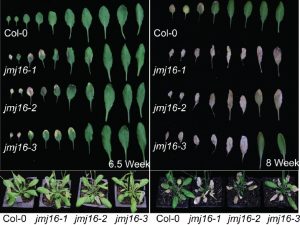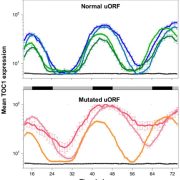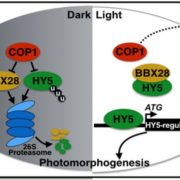Leaf senescence in Arabidopsis thaliana is regulated by a histone H3K4 demethylase (Plant Cell)
 Leaf senescence is the final stage of leaf development where the organ turns yellow and programmed cell death occurs. While it is generally understood that the regulation of senescence associated genes (SAGs) is dependent on the trimethylation of histone H3 at lysine 4 (H3K4me3), the exact mechanism is unknown. In a new study, authors Liu et al. identified a JmjC-domain containing protein (JMJ16) in Arabidopsis thaliana that negatively regulates senescence by acting as an H3K4 demethylase. The authors measured an increase in SAGs in the loss-of-function jmj16 mutants and genetic analysis confirms that JMJ16 represses the expression of two genes associated with senescence (WRKY53 and SAG201) by demethylating H3K4 at the loci of the genes. Furthermore, the protein abundance of JMJ16 decreases during leaf development, suggesting that down-regulation of JMJ16 is associated with the age of the leaf and a prerequisite for the initiation of leaf senescence. Overall, this study identifies the first enzyme responsible for the regulation of leaf senescence through histone methylation. (Summary by Nick Segerson) Plant Cell 10.1105/tpc.18.00693
Leaf senescence is the final stage of leaf development where the organ turns yellow and programmed cell death occurs. While it is generally understood that the regulation of senescence associated genes (SAGs) is dependent on the trimethylation of histone H3 at lysine 4 (H3K4me3), the exact mechanism is unknown. In a new study, authors Liu et al. identified a JmjC-domain containing protein (JMJ16) in Arabidopsis thaliana that negatively regulates senescence by acting as an H3K4 demethylase. The authors measured an increase in SAGs in the loss-of-function jmj16 mutants and genetic analysis confirms that JMJ16 represses the expression of two genes associated with senescence (WRKY53 and SAG201) by demethylating H3K4 at the loci of the genes. Furthermore, the protein abundance of JMJ16 decreases during leaf development, suggesting that down-regulation of JMJ16 is associated with the age of the leaf and a prerequisite for the initiation of leaf senescence. Overall, this study identifies the first enzyme responsible for the regulation of leaf senescence through histone methylation. (Summary by Nick Segerson) Plant Cell 10.1105/tpc.18.00693









